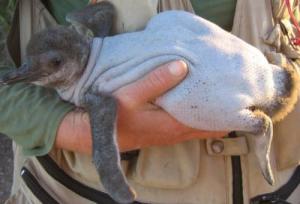A mysterious feather loss disorder has been hitting penguin chicks. These chicks also grow slower than feathered chicks and don’t find shelter from the sun like feathered chicks do. Find out more about it here.
Tag Archive: bird
This beautiful bird is a common one here in the United States. You can find them everywhere, but especially in parks or meadows. However they weren’t always so abundant here. These birds will actually roost together in winter in large groups of up to a quarter of a million birds. And like the passenger pigeon before them, these large roosts made hunting easy for those in the South who considered their meat a delicacy. However, as human numbers grew, their houses and buildings made great platforms for large robin nests and now they are protected under the US Migratory Bird Protection Act, so their range is expanding and they are doing quite well, although pesticides can still be a problem for them. These birds do eat insects as well as berries, but if they eat too many honeysuckle berries, they can get intoxicated!
Robins are usually the first to sing in the morning and they continue to sing through winter and fall. They are also the first to breed in a season (April-July) and will have 2-3 sets of young in a season. These guys are busy and have earned the well-deserved title of “the early birds,” which as you can see here…he he…gets the worms.
It is believed that robins find their worms by sight and some thrushes are known to stomp on the grass to mimic rain patterns in order to make their earthworm prey come to the surface for easier catching.
Our early birds also have to deal with predators, especially blue jays and snakes, and they do so by mobbing them, meaning attacking in groups. Some thrushes also defecate on their would be predators, leaving them to scurry off in a sticky, defeated mess. Win!

Meet Toulouse, a 38 year old turkey vulture. Note the see-through nostrils. Image taken at the San Francisco Zoo.
Toulouse, pictured above, is a cranky, old, arthritic turkey vulture who hates umbrellas, big wheels, big hats and balloons and likes sunny days and his turn to pick apart a rabbit head. I love this bird because at the end of the day, the bird knows what he wants. He’ll let you know it, too. Respect.
So today’s post is about turkey vultures. And not just because Toulouse is awesome. All turkey vultures are pretty cool. They are one of the few birds that have an excellent sense of smell, which helps them to locate the dead animals that they will rip apart and eat with that lovely sharp beak pictured above. Check out how large their nostrils are, too. You can see right through them! Points to any animal that you can see through the middle of their face. At any rate, most vulture species don’t even have a good sense of smell, so it’s a pretty unique characteristic.
In fact, it has been a pretty useful characteristic too. How you ask?
If there was a gas leak in your house right now, the way that you would recognize it is by the smell. However, natural gas has no scent. The gas companies add the scent so that you will be alerted if there’s a gas leak and you can leave the premises and you know, not die. The scent they use is from a chemical called ethyl mercaptan, which is a smell decaying animals emit as well. Apparently, several gas workers, from different companies, have said that when there was a gas leak, they would look for the turkey vultures hovering around the pipeline to show them where it was. Apparently, they still do this to this day, even though they have the assistance of more “sophisticated” tools now.
It’s been helpful for other animals, too. The black vulture is known to follow turkey vultures to help them find where the food is. The cheaters.
Cool as they are, turkey vultures can seem pretty gross to some people. Believe it or not, this handsome bird shown here will regurgitate his food if he gets scared. In the wild, that food would be putrid animal flesh. That has been partially digested. And then thrown up. Turkey vultures do this to be more light weight and to startle predators. They might also play dead. These birds are also known to defecate on their own feet, to cool off, and to use the acids in their waste to kill the bacteria on their feet that they get from walking on dead carcasses. Yum Yum.
By the way, if you see a turkey vulture that looks like this:

Toulouse the turkey vulture, with nictitating membrane over his eyes. Image taken at the San Francisco Zoo.
Run. He is amassing his strength to strike you down with the sheer power of his mind.
A note on this post- the use of ethyl mercaptan by turkey vultures to find food is one that is under debate by scientists. Here is one study that suggests that the amount of ethyl mercaptan emitted by the small decaying animals might not be enough to reach the turkey vultures that are foraging from high up in the sky. There does seem to be a general consensus, though, that they are using their sense of smell.
Check here for some more fun facts about turkey vultures.




